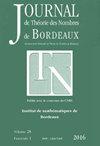极值西顿集是傅里叶一致的,并应用于划分正则性
IF 0.3
4区 数学
Q4 MATHEMATICS
引用次数: 0
摘要
推广了Erd\H{o}s-Freud和Lindstr\ om的结果,证明了整数有界区间的最大Sidon子集在Bohr邻域中是均匀分布的。我们通过证明极值西顿集是傅立叶-伪随机来建立这一点,因为它们没有大的非平凡傅立叶系数。作为进一步的应用,我们推导出,对于任何五个或更多变量的分割正则方程,极值西顿集的每一个有限着色都有一个单色解。本文章由计算机程序翻译,如有差异,请以英文原文为准。
Extremal Sidon Sets are Fourier Uniform, with Applications to Partition Regularity
Generalising results of Erd\H{o}s-Freud and Lindstr\"om, we prove that the largest Sidon subset of a bounded interval of integers is equidistributed in Bohr neighbourhoods. We establish this by showing that extremal Sidon sets are Fourier-pseudorandom, in that they have no large non-trivial Fourier coefficients. As a further application we deduce that, for any partition regular equation in five or more variables, every finite colouring of an extremal Sidon set has a monochromatic solution.
求助全文
通过发布文献求助,成功后即可免费获取论文全文。
去求助
来源期刊

Journal De Theorie Des Nombres De Bordeaux
MATHEMATICS-
CiteScore
0.60
自引率
0.00%
发文量
35
期刊介绍:
The Journal de Théorie des Nombres de Bordeaux publishes original papers on number theory and related topics (not published elsewhere).
 求助内容:
求助内容: 应助结果提醒方式:
应助结果提醒方式:


